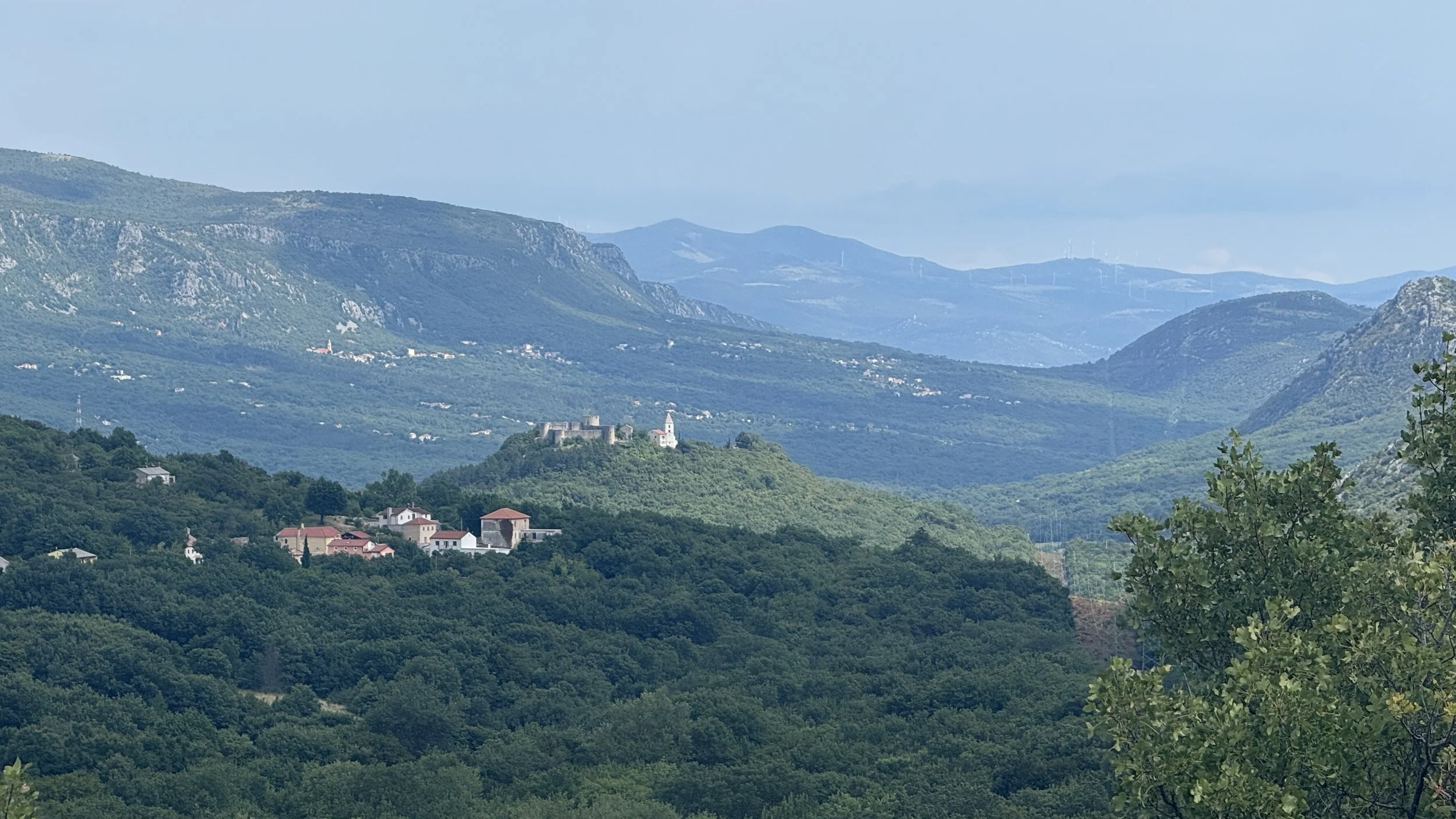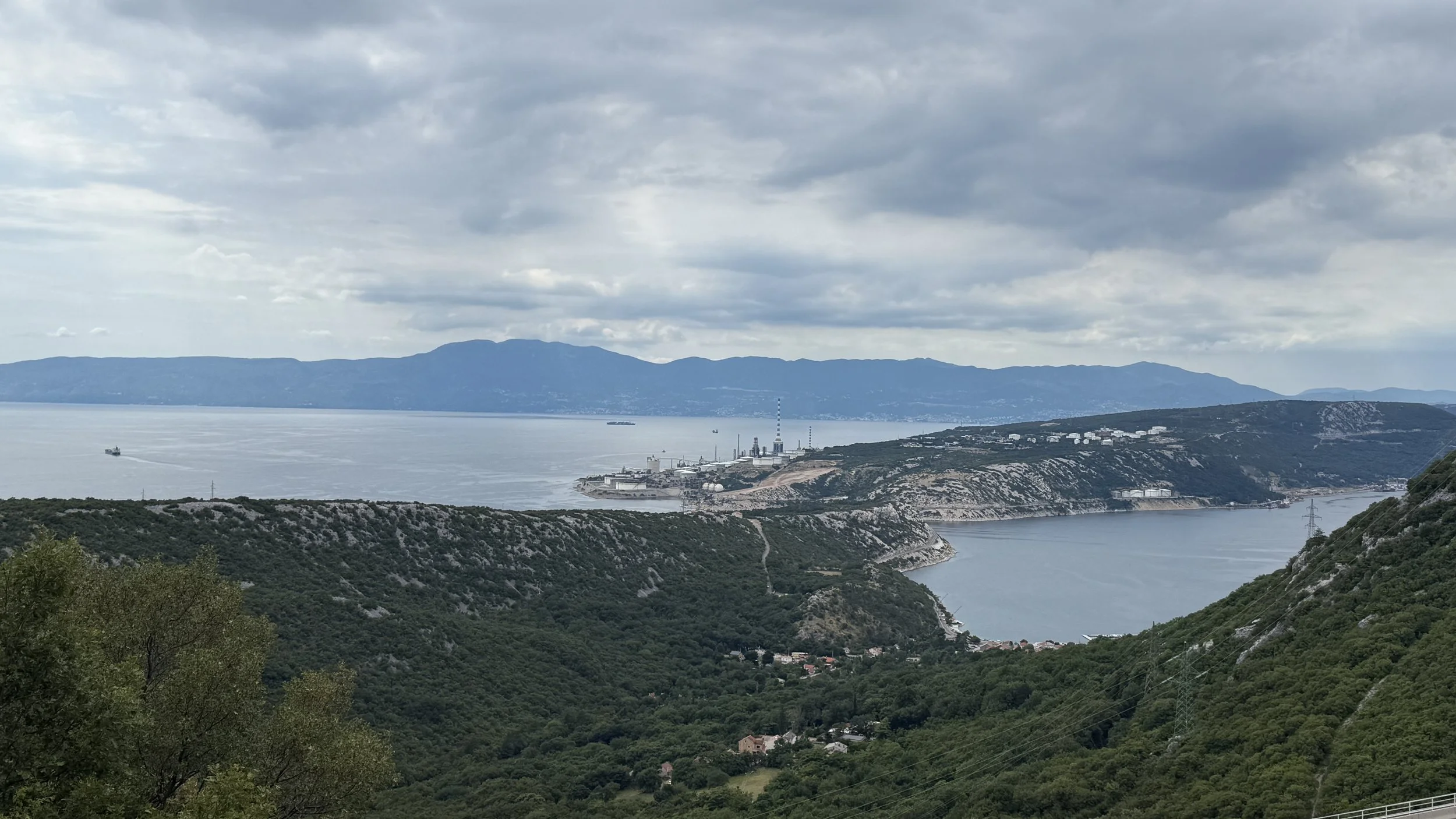Day 63 - July 12th: The Long & Winding Road
Rupa to Crikvenica: 34.4 miles / 1,746 total
Christina, Jax, and I ended up in the small town of Rupa for the night. Our daily task of sourcing a restaurant—close by, highly rated, and matching the mood—was greatly simplified, since there was only one within miles: a place called Carpe Diem. Oddly enough, it had over 700 reviews, which is a lot for a restaurant in any city, let alone a town of 345. We drove over around 6:45pm, unsure about local dining times. But unlike every other European country we’ve visited, where dinner starts at 7 or even 8pm, this was apparently prime time—it was packed. We were lucky to get a table. Indoors too, which is key in Europe if you want to avoid the smoking zone.
Two young women, maybe sisters, were running the front of house. When one delivered a dark beer and a light beer to the table next to us, I already liked the place. The whole vibe in this area has been Bavarian-ish—dark beer, light beer, cold mountain air, accordion-style music, and meat-heavy plates. I usually avoid meat while running, but it was hard to ignore the parade of cutting boards loaded with grilled meats coming out of the kitchen. Christina and I are perfectly matched food-wise and often land on the same dishes. So, we went for it.
Croatian is a mystery to both of us. At this point I can navigate menus in Italian, Spanish, French, and Portuguese, but Croatian felt like a different species. The only recognizable word on the menu was “hamburger”—and we saw exactly zero hamburgers being served. Thankfully, one of the girls spoke enough English to help us. We ended up with beef sausages, a spicy hamburger (really more like a kebab), fries, arugula salad, fresh-baked flatbread, and homemade sauces. It was one of the best meat meals I’ve had. The man next to us, working his way through a massive platter with a baby in a high chair, offered advice: meat, bread, raw onions, and sauce which was more of a paste. The meat he told us is a classic Balkan style that has Turkish roots. We left stuffed. Time would tell if there would be collateral damage on the run.
We slept with the windows open and layered up in the cool mountain air. The woman who ran the inn woke early and served me a full breakfast at 7am—Italian coffee, eggs, bread - a big meal, which would hopefully carry me through the day. I hit the road at 7:30am, fueled up and feeling ready.
The route out of Rupa climbed immediately into the mountains on a quiet road. Perfect weather: low humidity, some clouds, and about 60 degrees. Yesterday’s road in Slovenia hugged the spine of the mountains, but today’s route climbed, dipped, and twisted its way up toward the village of Skalnica—about 6 kilometers in.
From there, I began a long, slow descent toward the sea through the Vinodol Valley, a broad green gorge carved between the Dinaric Alps and the Adriatic. This region was once governed by the powerful Frankopan family, Croatian nobles who built a chain of castles to guard the valley and coastline. They were signatories to the Vinodol Code in 1288—one of the oldest legal documents in the Slavic world, and a landmark in Croatian civil law.
As I dropped lower, the views expanded. Off to the right I could see the vast sweep of the gorge.
I passed through the villages of Marcelji and Sarsoni and then began paralleling the major roadway E65. Despite the descent, there was little in the way of services. At Sveti Kuzam, around 32km in, I finally spotted a restaurant—packed with locals enjoying beers and plates of grilled meat and sausage soup. No non-meat options and only one server, so I pressed on.
At 39km, in Hreljin, I found a place that looked like it had just closed. A woman was cleaning up, and I asked if she had any food left. “Only soup with meat,” she said. I explained I couldn’t eat meat while running, and she nodded, then returned with soup and pasta. It hit the spot. Hreljin, incidentally, also has its own castle ruins which I passed —Hreljin Castle, another Frankopan fortress dating back to at least 1225, also a signer of the Vinodol Code.
Thirty minutes later I was back on the road. The final descent opened suddenly, and dramatically, onto the Adriatic Sea. At around 45km, the coast came into view. To my right: a massive oil refinery and port—possibly the largest I’ve ever seen. To the left: the wide Vinodol valley with Drivenik Castle and its adjacent church still visible on the hilltop. Straight ahead, the E65 climbed the ridgeline above the villages below.
After doing some research I found that the massive industrial complex I saw descending toward the Adriatic was the INA oil refinery at Urinj, part of the Port of Rijeka, Croatia’s largest seaport. Founded in 1883, it’s one of Europe’s oldest refineries and remains a key hub for oil processing and distribution. Set in the Bay of Bakar, the facility includes sprawling storage tanks, pipelines, and maritime terminals that handle millions of tons of crude and refined products annually. Its scale and coastal position make it a dominant presence along this stretch of the Adriatic.
With 4km to go on E65 and the traffic thick, I threw on music and put my head down. The road had no shoulder, just guardrails and cliffs—stressful, but I knew it was the last stretch. Eventually I reached the turnoff for Crikvenica and descended the 500’ into the Hotel Miramar which was across the street from the sea.
Coming from flat Florida, the geography here is striking—jagged mountains, carved roads, sea on one side, and valleys full of history on the other. If I have to stick to the E65 much longer, it’ll make for some rough days, so I’m hoping to find alternate routes as I head south along the coast.
Housekeeping:
Lisa, I still haven’t put any lube on my feet this whole trip—can’t stand the sliding or the mess. That and cold baths are my limits!
Bob, Breno bi bil rock zvezda v Sloveniji in na Hrvaškem, tukaj bi morali odpreti Espeto!
Thanks for following along and for all the support.
Cheers,
David.







